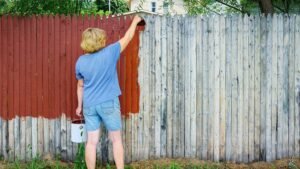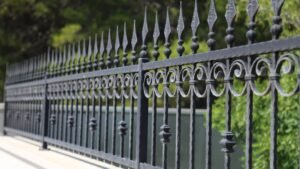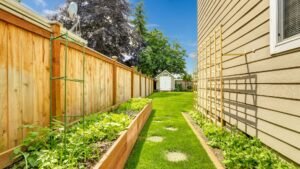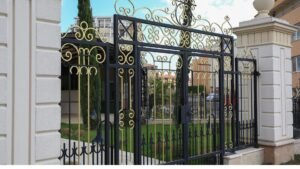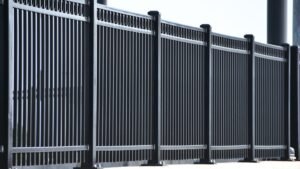Welcome to your comprehensive guide on how long composite fences last! If you’re tired of replacing or constantly maintaining traditional wooden fences, you’re likely looking for a long-term solution, and composite fencing might be the answer. In this article, we’ll dive into everything you need to know about the lifespan of composite fences, why they are a popular choice for homeowners, and the key factors that influence their durability. Whether you’re considering installing one or simply curious about their longevity, we’ll provide you with practical insights to help you make an informed decision about whether a composite fence is right for your home.
Composite fences typically last between 25 to 30 years with minimal maintenance. Made from a combination of wood fibers and plastic, these fences are designed to withstand weather conditions, resist rot and insects, and avoid the common issues that affect traditional wood fences. With occasional cleaning, composite fences can maintain their appearance and durability, making them a long-lasting option for homeowners.
Table of Contents
What Is A Composite Fence?
When exploring the various types of fencing materials available today, you may come across the term “composite fence.” But what exactly does that mean, and how does it differ from more traditional options like wood or vinyl? Let’s dive into the details to understand what makes composite fencing a popular choice for homeowners.
Definition of Composite Material
Composite materials are an innovative blend, typically made from a mixture of wood fibers and plastic. These materials are engineered to combine the best qualities of both components, offering a modern alternative to classic wood or vinyl fencing. The wood fibers give composite fences the natural look and feel that many homeowners desire, while the plastic provides added strength and durability.
One key distinction between composite fences and traditional wood fences is how they handle weather and aging. While wooden fences are prone to rot, warping, and insect damage, composite fences are designed to resist these issues. Similarly, compared to vinyl, which can crack or become brittle over time due to extreme temperatures, composite materials are built to maintain their integrity in a variety of conditions.
This hybrid nature of composite materials offers a balance of aesthetics, strength, and resilience that you won’t often find in single-material fencing solutions.
Benefits of Composite Fencing
1. Durability
One of the standout advantages of composite fencing is its remarkable durability. Thanks to the combination of wood fibers and plastic, composite fences are resistant to many of the problems that typically affect wood or vinyl fences. They won’t rot, splinter, or warp, and they’re also less likely to suffer damage from insects like termites. Additionally, composite fences are built to withstand various weather conditions, making them a smart investment for long-term fencing solutions.
2. Low Maintenance
Unlike traditional wood fences that require regular staining, painting, or sealing to maintain their appearance, composite fences need minimal upkeep. A simple cleaning with water and mild soap is usually enough to keep them looking fresh. This low-maintenance feature saves both time and money, making composite fencing an appealing option for busy homeowners who prefer a fence that looks great without the hassle of constant upkeep.
3. Aesthetic Appeal
Composite fences are designed to mimic the natural appearance of wood, offering the same warm, earthy tones and textures that many homeowners love. However, unlike real wood, composite materials maintain their appearance for years without fading or losing their visual appeal. Composite fences come in a variety of colors and styles, allowing homeowners to choose an option that best complements their outdoor space.
4. Eco-Friendliness
In today’s eco-conscious world, many homeowners are looking for more sustainable options when it comes to home improvements. Composite fencing offers an environmentally friendly choice, as it is often made from recycled materials such as reclaimed wood and recycled plastic. By opting for composite fences, you’re contributing to reducing waste and making a greener choice for your property.
In conclusion, composite fencing represents the perfect blend of beauty, strength, and sustainability. It offers the rich aesthetic appeal of wood, the durability of plastic, and the eco-conscious benefits of recycled materials. If you’re seeking a fence that stands the test of time with minimal maintenance, composite fencing is certainly worth considering.

Average Lifespan Of A Composite Fence
Composite fences are renowned for their durability and longevity, making them a popular choice for homeowners seeking a low-maintenance and aesthetically pleasing fencing solution. On average, a composite fence can last 25-30 years, making it a long-term investment that offers both functionality and curb appeal.
Many leading manufacturers back their composite fences with warranties that span 20 to 30 years, which reflects their confidence in the product’s longevity. These warranties not only provide peace of mind for homeowners but also serve as an indication of the expected lifespan of composite fencing. It’s important to note that while the warranty period is a solid indicator, factors such as climate, installation quality, and maintenance can impact the overall lifespan of a composite fence.
Composite Fences vs. Other Fence Types: How Do They Compare?
When deciding on the best fencing material for your property, it’s essential to consider how composite fences stack up against other common fence types in terms of longevity. Here’s a quick comparison:
- Wood Fences (10-15 years): Wood fences, while traditional and classic in appearance, are often vulnerable to natural elements. Over time, they become susceptible to issues like rot, termite damage, and weather-related deterioration. Without regular maintenance, such as staining, painting, and treating, the lifespan of wood fences is often limited to 10-15 years.
- Vinyl Fences (20-30 years): Vinyl fences are another low-maintenance option that can last 20 to 30 years. However, extreme weather conditions, particularly freezing temperatures, can cause vinyl to become brittle and crack. While they offer a similar lifespan to composite fences, vinyl fencing is not as resistant to the elements in all environments.
- Metal Fences (20-40 years): Metal fences, particularly those made from steel or wrought iron, can last between 20 to 40 years, depending on the level of care they receive. Without proper maintenance, such as rust prevention and regular painting, metal fences can corrode over time, shortening their lifespan. However, when well-maintained, they can outlast both vinyl and wood fences.
Visual Comparison of Fence Lifespans
When comparing the typical lifespans of different fencing materials, composite fences stand out for their durability. Here’s how they stack up against other popular fence types:
- Composite Fences: With an average lifespan of 25-30 years, composite fences require minimal maintenance and are highly resistant to the elements. Their longevity is reflected in the warranties offered by top manufacturers, often ranging from 20 to 30 years.
- Wood Fences: On the other hand, wood fences typically last 10-15 years. While they may offer a classic look, wood is vulnerable to rot, termites, and weather damage. Regular maintenance such as staining, sealing, and repairs is essential to extend their life.
- Vinyl Fences: Vinyl fences offer a comparable lifespan to composite, lasting 20-30 years. However, they can become brittle and crack in extreme weather conditions, particularly in freezing temperatures. Vinyl requires occasional cleaning to maintain its appearance but generally needs little maintenance beyond that.
- Metal Fences: Metal fences, particularly those made of steel or wrought iron, can last 20-40 years. While durable, they require rust prevention treatments and occasional painting to maintain their longevity. Without proper care, metal fences are prone to corrosion, especially in areas with high humidity or salt exposure.
In summary, composite fences offer a strong balance of long life and minimal upkeep, outlasting wood fences and competing closely with vinyl and metal options. Each material has its own pros and cons, but composite remains a popular choice for homeowners seeking both durability and low maintenance.
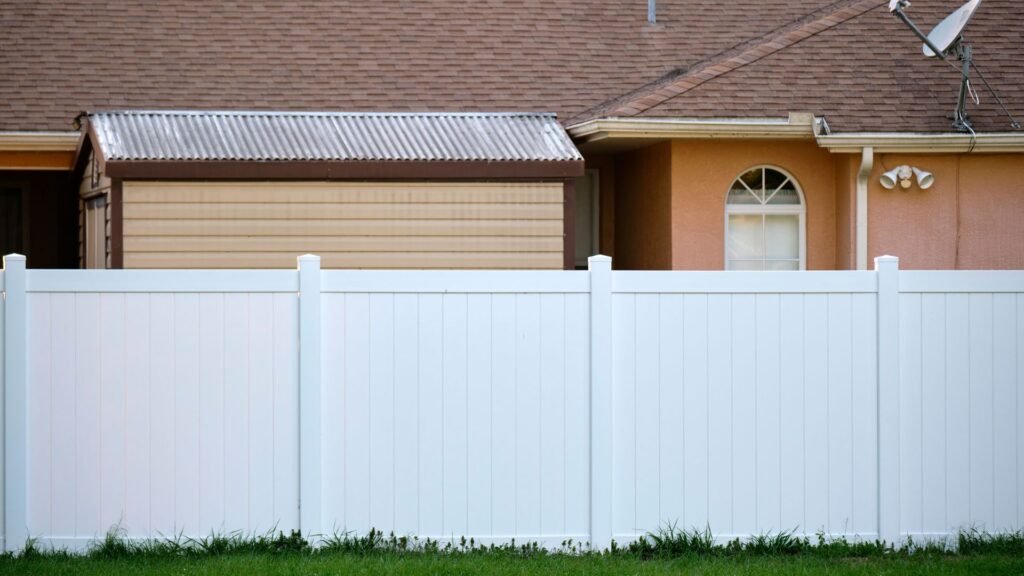
Factors That Impact The Lifespan Of Composite Fences
When considering installing a composite fence, it’s important to understand the key factors that can influence its durability and overall lifespan. Composite fencing is known for its long-lasting properties, but specific variables can affect just how long it will maintain its functionality and aesthetic appeal. Let’s explore these factors in more detail:
1. Quality of the Composite Material
The quality of the composite materials used plays a critical role in determining the fence’s longevity. Premium-grade composite fences tend to be more durable and resistant to wear and tear compared to lower-quality alternatives. Brands and manufacturers employ different manufacturing techniques, so it’s essential to choose a reputable company that uses advanced production methods. High-quality composite fences are typically made from a blend of recycled wood fibers and plastics, engineered to withstand environmental elements. Opting for superior materials not only ensures a longer lifespan but also reduces the chances of cracking, warping, or other structural issues.
2. Weather Conditions and Climate
Composite fences are designed to perform well in a wide range of weather conditions. They are particularly resilient to moisture, which makes them an excellent choice for areas that experience heavy rain or humidity. Unlike traditional wood, composite materials resist water absorption, significantly lowering the risk of rot, mildew, and mold. However, in climates with extreme UV exposure, there can be a slight fading of color over time. Fortunately, this does not affect the fence’s structural integrity, and modern composites often include UV inhibitors to minimize color loss. Composite fencing also stands up to harsh winters and hot summers, maintaining its strength through freezing and thawing cycles.
3. Maintenance Practices
One of the most appealing aspects of composite fencing is its low-maintenance nature. Unlike wood, composite fences don’t require regular staining, painting, or sealing to preserve their appearance and strength. However, occasional cleaning can help extend their lifespan and keep them looking fresh. A simple wash with mild soap and water is usually enough to remove dirt, grime, or algae that might accumulate over time. Regularly removing debris that could cause scratches or dents will further help maintain the fence’s surface. Proper maintenance doesn’t require much effort but can contribute significantly to ensuring the fence stays in good condition for decades.
4. Installation Quality
The installation process is another critical factor that impacts the longevity of composite fences. Even the best-quality materials can fail to perform as expected if the fence is not installed correctly. A poorly installed fence may suffer from misalignment, inadequate support, or uneven sections, leading to premature wear and tear. For this reason, it’s strongly recommended to hire a professional fencing contractor who has experience working with composite materials. Professionals will ensure that the posts are properly anchored and aligned, minimizing the chances of sagging or instability, which can compromise the fence’s lifespan over time.
5. Ground Conditions and Soil Stability
The stability of the ground where the fence is installed can have a significant effect on its durability. Composite fences rely on a solid foundation to remain sturdy, and shifting soil can weaken that foundation over time. If the soil around the fence posts becomes unstable, the fence may start to lean, warp, or even collapse in extreme cases. Proper drainage is also crucial to prevent water from pooling around the base of the fence posts, which could cause long-term damage even to composite materials. If you’re installing a composite fence in an area prone to erosion, flooding, or poor drainage, extra precautions should be taken to ensure the ground is properly stabilized before installation.
Composite fences are an excellent investment for those seeking a durable, long-lasting fencing solution. By paying attention to factors such as the quality of materials, weather conditions, maintenance, installation, and soil stability, homeowners can maximize the lifespan of their composite fences and enjoy the benefits of low-maintenance, aesthetically pleasing boundaries for many years to come.

Maintenance Tips To Prolong The Life Of A Composite Fence
To ensure your composite fence remains in excellent condition for many years, a few key maintenance practices should be followed. These simple yet effective steps will help protect your investment and keep your fence looking its best.
1. Regular Cleaning
Over time, composite fences can accumulate dirt, dust, and grime, which can impact their appearance. To maintain a clean and attractive fence, regular cleaning is essential. The good news is that cleaning a composite fence is straightforward.
Simply mix mild soap or detergent with warm water and use a soft brush or cloth to gently scrub the surface. This method helps remove dirt, stains, and even mold or mildew that may develop over time, especially in areas with high humidity. Rinse the fence thoroughly with a garden hose to ensure no soapy residue is left behind. This routine cleaning, ideally done at least twice a year, helps prevent buildup and preserves the fence’s aesthetic appeal.
2. Inspections for Damage
Annual inspections are crucial for maintaining the structural integrity of your composite fence. By checking the fence regularly, you can spot any potential issues early on, such as loose posts, broken panels, or warping. Look for signs of wear and tear, including any cracks or bends that could worsen over time.
During inspections, ensure all posts are securely anchored and the fence panels are properly aligned. If you notice any loosened sections or damaged parts, address them promptly. By catching minor issues early, you can prevent them from developing into larger, costlier problems. Keeping up with regular inspections ensures that your fence continues to provide the security and privacy it was designed for.
3. Landscaping Considerations
The environment around your fence can play a significant role in its longevity. While it might be tempting to plant trees, shrubs, or flowers near your fence for aesthetic reasons, this can lead to potential problems. Plants, particularly those with extensive root systems, can affect the stability of your fence over time. Roots may push against the fence posts, causing misalignment or loosening.
Moreover, moisture from nearby plants, especially if they are watered frequently, can increase the chances of mold growth on the fence or cause long-term damage to its structure. To avoid this, ensure there is sufficient space between your landscaping and the fence, allowing for proper airflow and reducing the risk of moisture buildup. Trimming back any plants or trees that grow too close to the fence will also help prevent potential damage.
4. Avoiding Heavy Impact
Although composite fences are designed to be highly durable and resistant to weather conditions, they are not entirely immune to damage from heavy impact. Lawn equipment, such as weed trimmers or lawnmowers, can accidentally collide with the fence and cause scratches or dents. Falling branches during storms can also result in minor damage to the surface of the fence.
To prevent such issues, it’s advisable to be cautious when working near the fence. Make sure to clear any overhanging branches that might fall during strong winds or heavy rain. Additionally, when using lawn equipment, maintain a safe distance to avoid unintended contact with the fence. Being mindful of these factors will help protect the fence from unnecessary wear and tear, allowing it to maintain its structural integrity for years to come.
By following these simple yet effective maintenance tips, you can significantly extend the lifespan of your composite fence. Regular cleaning, timely inspections, careful landscaping, and avoiding heavy impact are all essential practices for keeping your fence in top condition. With proper care, your composite fence will continue to enhance the beauty and privacy of your outdoor space for many years.

How Composite Fences Compare To Other Fencing Materials In Terms Of Longevity
Choosing the right fencing material is crucial, not only for aesthetic reasons but also for its long-term durability. Composite fencing has become a popular choice for homeowners and businesses alike, largely because of its longevity and minimal maintenance needs. Below, we’ll compare composite fences with other common fencing materials—wood, vinyl, and metal—so you can make an informed decision for your property.
1. Composite vs. Wood Fences
Wood fences have been a classic choice for years due to their natural appearance and affordability. However, wood is highly susceptible to various issues that compromise its durability over time. Exposure to moisture leads to rot, especially in regions with heavy rainfall or high humidity. Wood is also prone to insect infestations, particularly termites, which can weaken the structure over time. Additionally, warping and cracking are common issues as wood expands and contracts with temperature changes.
In contrast, composite fences are designed to eliminate these concerns. Made from a blend of recycled wood fibers and plastic, composite fences are engineered to resist moisture, meaning they won’t rot like traditional wood. The material is also impervious to insect damage, making it a more resilient choice. Unlike wood, composite doesn’t warp or crack due to weather conditions, offering a much longer-lasting performance with less maintenance. For those who want the look of wood without the constant upkeep, composite fencing offers the perfect solution.
2. Composite vs. Vinyl Fences
Vinyl fencing is another popular alternative due to its sleek, modern appearance and relatively low maintenance. However, vinyl has its limitations, especially when it comes to durability in extreme weather conditions. Vinyl fences tend to crack or become brittle when exposed to very high or low temperatures. In areas with freezing winters or scorching summers, this can lead to significant damage over time, requiring costly repairs or replacements.
Composite fences, on the other hand, are built to withstand a wide range of temperature extremes. The combination of wood fibers and plastic creates a material that’s not only flexible but also more resistant to impact. This means that whether you’re dealing with a sweltering heatwave or a cold snap, a composite fence is less likely to crack or suffer damage. This makes composite fences a more reliable choice for homeowners in regions with fluctuating weather conditions.
3. Composite vs. Metal Fences
Metal fences, whether made from iron, steel, or aluminum, are known for their strength and security. However, metal is highly susceptible to rust and corrosion, especially in humid or coastal areas where moisture and salt can accelerate deterioration. To maintain a metal fence’s appearance and functionality, frequent upkeep is necessary, including painting, rust treatments, or even replacing parts.
Composite fences, by comparison, offer excellent resistance to rust and corrosion, as they contain no metal components. This makes them ideal for homeowners seeking a low-maintenance option in environments where moisture and salt are prevalent. While metal fences can corrode over time and require constant attention to prevent damage, composite fencing remains resilient, looking as good as new for many years with minimal effort. This makes composite fencing a more convenient option in terms of long-term maintenance and upkeep.
4. Initial Cost vs. Long-Term Value
When it comes to cost, composite fencing does have a higher upfront price compared to materials like wood and vinyl. However, this initial investment pays off over time. Wood fences require regular staining, sealing, and repairs, while vinyl and metal fences often need replacements or treatments due to weather damage. Composite fences, by contrast, need little more than an occasional wash to keep them looking pristine.
Over the lifespan of the fence, the lower maintenance and replacement costs of composite materials can save homeowners a significant amount of money. Additionally, composite fences tend to have a longer lifespan than wood, vinyl, and even some metal options, further increasing their value over time. For homeowners who prioritize long-term durability and low upkeep, the initial cost of composite fencing is outweighed by the long-term savings and peace of mind.
In summary, when comparing composite fences to wood, vinyl, and metal alternatives, composite stands out for its longevity and low-maintenance needs. While wood may offer natural beauty, it is prone to damage from insects and weather. Vinyl, though modern and sleek, is vulnerable to cracking in extreme temperatures. Metal, while strong, is susceptible to rust and requires constant maintenance. Composite fencing, despite its higher upfront cost, offers a long-term value that is hard to beat, making it an excellent investment for any property owner looking for durability, aesthetics, and minimal maintenance over the years.

Common Myths About Composite Fences
Composite fences have gained immense popularity in recent years due to their durability, aesthetic appeal, and low-maintenance features. However, despite their benefits, several misconceptions still surround composite fencing. In this section, we’ll debunk some of the most common myths and provide clarity on why composite fences are an excellent choice for homeowners.
Myth 1: Composite Fences Look Artificial
One of the most widespread myths about composite fencing is that it looks artificial or plastic-like. Many people believe that because composite materials are man-made, they can’t offer the same natural beauty as traditional wood. However, this assumption is outdated.
Modern composite fencing technology has advanced significantly, allowing manufacturers to produce fences that closely mimic the appearance of natural wood grain. These fences are available in a variety of textures and colors, offering realistic wood-like finishes that are nearly indistinguishable from actual wood. In fact, some composite fences even incorporate varying tones and patterns to create a more authentic look. The result? A fence that captures the warmth and charm of wood, without the constant need for staining, sealing, or painting.
So, if you’re concerned that a composite fence will look out of place or unnatural in your yard, rest assured—today’s composite fences are designed to blend seamlessly with any outdoor space, providing both elegance and functionality.
Myth 2: Composite Fences are Prone to Fading
Another common myth is that composite fences fade quickly, losing their color and aesthetic appeal within a short time. While it’s true that all outdoor materials are exposed to UV rays, which can cause some fading, the belief that composite fences are especially prone to this is a misconception.
Modern composite fences are engineered to resist fading much more effectively than earlier generations of synthetic fencing materials. High-quality composite fences undergo rigorous testing and are treated with UV stabilizers that protect against sun damage. Any fading that does occur happens very gradually and over a period of decades—not months.
Homeowners can expect their composite fences to maintain their vibrant appearance with only slight color changes due to natural weathering. Additionally, unlike wood, which may require frequent repainting or staining, composite fences offer the peace of mind that comes with minimal maintenance, all while retaining a rich, natural color.
Myth 3: Composite Fences are Hard to Install
Many people assume that composite fences are difficult to install, requiring advanced tools and skills compared to traditional wood or vinyl fencing. While it’s true that professional installation is often recommended for the best results, composite fences are actually designed with ease of installation in mind.
Composite fence panels are typically manufactured in pre-assembled sections, which can significantly reduce the time and effort required for installation. The interlocking systems and modular designs found in most composite fences make them easier to handle compared to traditional wood, which may need to be custom-cut and assembled on-site. Furthermore, many composite fence manufacturers provide detailed installation instructions and support, allowing even moderately experienced DIYers to tackle the project themselves with confidence.
Professional installation ensures a perfect fit and finish, but if you’re comfortable with basic tools, you can install a composite fence without the headaches often associated with other materials. And unlike wood, composite fences don’t warp, crack, or shrink, which can save you from future repairs down the line.
By dispelling these myths, it’s clear that composite fences offer a host of advantages over traditional fencing materials. From their natural wood-like appearance to their resistance to fading and ease of installation, composite fences provide a durable and aesthetically pleasing solution for homeowners looking to enhance their outdoor spaces.

Final Verdict: Are Composite Fences Worth It?
When considering a fencing solution for your home, composite fences stand out as a durable and eco-friendly option. Let’s dive deeper into the main advantages, cost implications, and which homeowners will benefit most from this type of fencing.
Summary of Benefits
One of the standout features of composite fences is their longevity. Built from a combination of recycled wood fibers and plastic, composite fencing is designed to withstand harsh weather conditions, from intense sunlight to heavy rain, without warping, rotting, or cracking. Unlike traditional wood fences that require constant attention, composite fences are virtually maintenance-free. This means no yearly painting, staining, or repairs are necessary, making them a low-maintenance choice for busy homeowners.
Additionally, composite fencing is an environmentally friendly option. Many manufacturers use recycled materials to create their products, reducing the demand for new lumber and keeping plastics out of landfills. For those who are looking to reduce their carbon footprint while still adding beauty and function to their property, composite fences make an excellent choice.
Investment Perspective
While composite fencing may come with a higher upfront cost compared to traditional wood or vinyl fences, it’s important to look at the big picture. Over time, composite fences can actually save you money. Traditional wood fences often need to be replaced after 10 to 15 years, and in the meantime, you’ll spend time and money on upkeep—repainting, resealing, or replacing damaged boards.
In contrast, composite fences require minimal maintenance. This results in significant long-term savings on maintenance materials, repair costs, and labor. Additionally, the durability of composite fences means they can last up to 25 years or more without needing replacement, making it a smart investment for homeowners who plan to stay in their homes for the long haul.
Suitability for Different Homeowners
Composite fences are especially well-suited for homeowners seeking long-term solutions. If you’re someone who prefers not to deal with regular upkeep, this fence is ideal for you. It’s also perfect for those who want to increase the value of their property without compromising on aesthetics or durability.
Furthermore, eco-conscious homeowners will appreciate the sustainable aspect of composite fencing. Knowing that you’re contributing to reducing waste and using recycled materials adds an additional layer of satisfaction.
Overall, composite fences offer a combination of durability, low-maintenance, and eco-friendliness, making them an attractive option for various types of homeowners. While the initial investment may be higher, the long-term benefits far outweigh the costs, ensuring a wise investment for the future of your home.

FAQs: About How Long Do Composite Fences Last
How long do composite fences typically last?
Composite fences typically last between 25 to 30 years. Their longevity depends on factors such as climate, installation quality, and maintenance, but they generally outlast traditional wood fences.
Do composite fences require a lot of maintenance?
No, composite fences are known for being low maintenance. Unlike wood, they do not require staining, sealing, or painting. Occasional cleaning with soap and water is usually sufficient to keep them in good condition.
How do composite fences compare to wood fences in terms of lifespan?
Composite fences generally last longer than wood fences. While wood fences may last around 10 to 15 years depending on care and weather conditions, composite fences can last 25 to 30 years or more due to their resistance to rot, insects, and weather damage.
Are composite fences eco-friendly?
Yes, composite fences are considered eco-friendly. They are typically made from recycled materials, such as wood fibers and plastic, reducing the need for virgin materials and minimizing waste.
Do composite fences fade over time?
While composite fences may experience some fading due to UV exposure, the fading is gradual and minimal. Most manufacturers offer UV-resistant coatings or treatments to slow down this process, ensuring the fence retains its color for many years.
Can composite fences withstand extreme weather conditions?
Yes, composite fences are designed to withstand a wide range of weather conditions, including rain, snow, and intense sunlight. They are resistant to moisture damage, rot, and warping, making them ideal for various climates.
Are composite fences more expensive than wood fences?
Composite fences generally have a higher upfront cost compared to wood fences. However, the long-term savings on maintenance, repairs, and replacement make them a cost-effective option over time.
Do composite fences look like real wood?
Modern composite fences are designed to closely mimic the appearance of natural wood, with various color and texture options that replicate wood grain. This allows homeowners to enjoy the aesthetic of wood without the upkeep.
Can I install a composite fence myself, or do I need professional help?
While it is possible to install a composite fence yourself if you have the right tools and experience, professional installation is recommended for best results. Proper installation ensures the fence lasts as long as intended and avoids issues with alignment or stability.
Are composite fences a good long-term investment?
Yes, composite fences are a great long-term investment. Although they may cost more upfront, their durability, low maintenance, and long lifespan provide significant value over time, especially compared to the ongoing costs of maintaining a wood fence.
Conclusion
In conclusion, composite fences offer a durable and long-lasting solution for homeowners, with a typical lifespan of 25 to 30 years. They are built to withstand the elements and require minimal maintenance, making them a cost-effective, long-term investment. If you’re looking to enhance your yard with a fence that combines longevity, aesthetic appeal, and sustainability, composite fencing is definitely worth considering. Be sure to explore additional resources for installation services or obtain a quote tailored to your needs. What do you think—would a composite fence be the perfect fit for your outdoor space? We’d love to hear your thoughts and experiences in the comments!
About the Author:
Mike Veail is a recognized digital marketing expert with over 6 years of experience in helping tradespeople and small businesses thrive online. A former quantity surveyor, Mike combines deep industry knowledge with hands-on expertise in SEO and Google Ads. His marketing strategies are tailored to the specific needs of the trades sector, helping businesses increase visibility and generate more leads through proven, ethical methods.
Mike has successfully partnered with numerous companies, establishing a track record of delivering measurable results. His work has been featured across various platforms that showcase his expertise in lead generation and online marketing for the trades sector.
Learn more about Mike's experience and services at https://theleadguy.online or follow him on social media:


